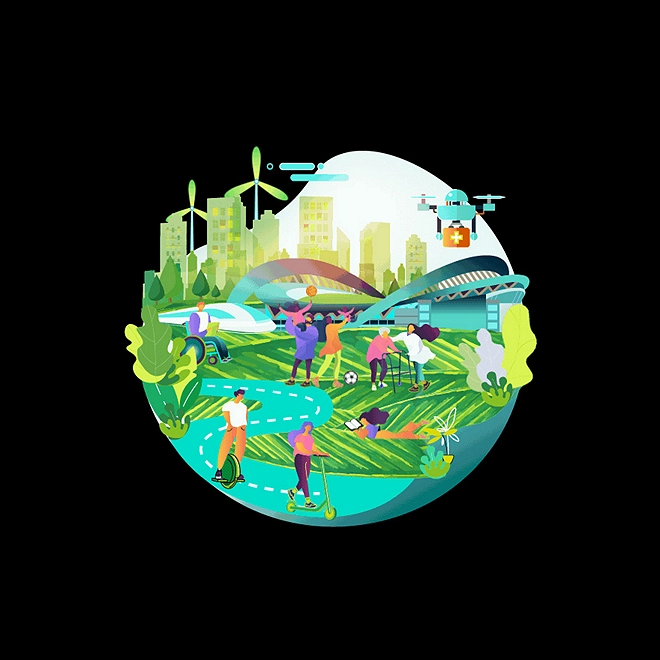Future-proofing cities in a post-pandemic world
Four capabilities to build resiliency in cities
This article focuses on how cities can build resiliency in public health systems, government operations, and other city domains by focusing on four key capabilities— nimbleness, scalability, stability, and optionality. Our recommendations are informed by a global survey of 167 cities conducted by Deloitte and ESI ThoughtLab to identify challenges and track progress made by cities in each of the key capabilities of resiliency.
A lesson in resiliency during the COVID-19 pandemic
In September 2020, when most of the world was grappling with COVID-19, life in Singapore seemed almost normal. Not only were businesses, workplaces, restaurants, and other public places fully open, limited air travel was also permitted. How was this possible when most countries were caught off-guard in dealing with a crisis that hit them out of nowhere? Turns out, much of it can be attributed to the implementation of the SG Clean initiative that required individuals and businesses to follow a set of good hygiene habits and rules. Singapore was prepared. The SG Clean initiative wasn’t a knee-jerk reaction to the COVID-19 pandemic. Its implementation can be traced all the way back to the systems put in place after 2009 H1N1 outbreaks. First, after the H1N1 outbreak, the government launched the Public Health Preparedness Clinic initiative (PHPC). The PHPC is a network of more than 900 clinics that help provide a consolidated primary care response in public health emergencies, such as the COVID-19 pandemic. In the early days of the pandemic, these clinics provided subsidized care to more than 70% of patients who had contracted the novel coronavirus within the first two days of the onset of symptoms.
Second, in 2014, the Ministry of Health in Singapore implemented the PPE national stockpile and rotation system. The public health system maintained a 3-6 month of PPE stockpile, and vendors resupplied PPEs whenever the stockpile fell below the 90% baseline stock. These stockpiles came in handy during the COVID-19 surge as they ensured adequate PPE availability for health care and frontline workers.
Third, Singapore’s years of investments in technology and digital infrastructure paid dividends during the current pandemic. This digital backbone allowed the city-state to launch a series of citizen-centric apps and portals that helped them find masks, get financial support, identify crowded places to avoid, and get accurate information via government chatbots.
Singapore was able to respond to COVID-19 better than most countries, states, and cities due to a primary focus over the years on building resiliency. It hadn’t seen COVID-19 coming in a crystal ball; it had the physical and digital systems in place for such types of disruptions. After more than a year of the COVID-19 pandemic, cities are still recovering and adapting to the new normal. As the focus shifts from managing the public health crisis to strengthening the public health system and reinvigorating economic recovery, cities should be building long-term resiliency.
Resiliency no longer a buzzword; it’s time for action
Resilience has been a popular term in the management lexicon for years. But its relevance has rarely been this important. In simple terms, the Organization for Economic Co-operation and Development defines resilience as a city or an urban center's ability to prepare for, respond to, recover, and adapt from a disruptive event.
Singapore’s experience in responding to the pandemic provides some important lessons on resiliency. One, it takes years of concerted efforts to build resiliency; it is primarily a capacity-building exercise with a strong focus on areas with the biggest gaps. In Singapore’s case, some of the initiatives that have paid off today were implemented and improved over a 20 year period. Two, the efforts should be at scale and cover all city functions and domains. Singapore purposefully built capacity in public health systems, IT infrastructure, supply chain, and more, to build resiliency.
Deloitte's upcoming book The Transformation Myth defines four key capabilities found in resilient organizations—nimbleness, scalability, stability, and optionality. These four capabilities can be used in the city context to understand the progress cities have made in evolving long-term resiliency.
- Nimbleness: The way a city acts and reacts to situations with speed, decisiveness, and changes direction as the situation demands.
- Scalability: A city's ability to respond to an unanticipated, and sometimes exponential, increase or decrease in demand in a short period.
- Stability: A city’s ability to remain firm in the present with its operations while also experimenting and scaling solutions for the future.
- Optionality: The way a city can augment its operations and services by tapping into a broader ecosystem of players, including the private sector, startups, technology companies, academia, and nonprofit organizations, and in turn, allowing it to be even more nimble, scalable, and stable.
Conclusion
Cities have an opportunity to learn from the COVID-19 crisis to build resiliency in their systems, operations, and infrastructure. Just like the COVID-19 pandemic, the next disruptive event could blindside many. But it will be unfortunate if our cities are not prepared for it. The four capabilities explored in this article could be crucial for cities to build resiliency, help withstand future shocks, and bounce back quickly.
Read the full report here
About Deloitte Center for Government Insights
The Deloitte Center for Government Insights shares inspiring stories of government innovation, looking at what’s behind the adoption of new technologies and management practices. We produce cutting edge research that guides public officials without burying them in jargon and minutiae, crystalizing essential insights in an easy-to absorb format. Through research, forums, and immersive workshops, our goal is to provide public officials, policy professionals, and members of the media with fresh insights that advance an understanding of what is possible in government transformation. For further information, please visit Deloitte Center for Government Insights.
About Smart Cities
Deloitte has an ambition to impact the lives of more than 100 million people now and in future generations. How? By helping to improve citizens’ quality of life, solve key urban challenges, and positively contributing towards the United Nation’s Sustainable Development Goal 11: Make cities and human settlements inclusive, safe, resilient, and sustainable. To learn more, please vist Smart Cites.

